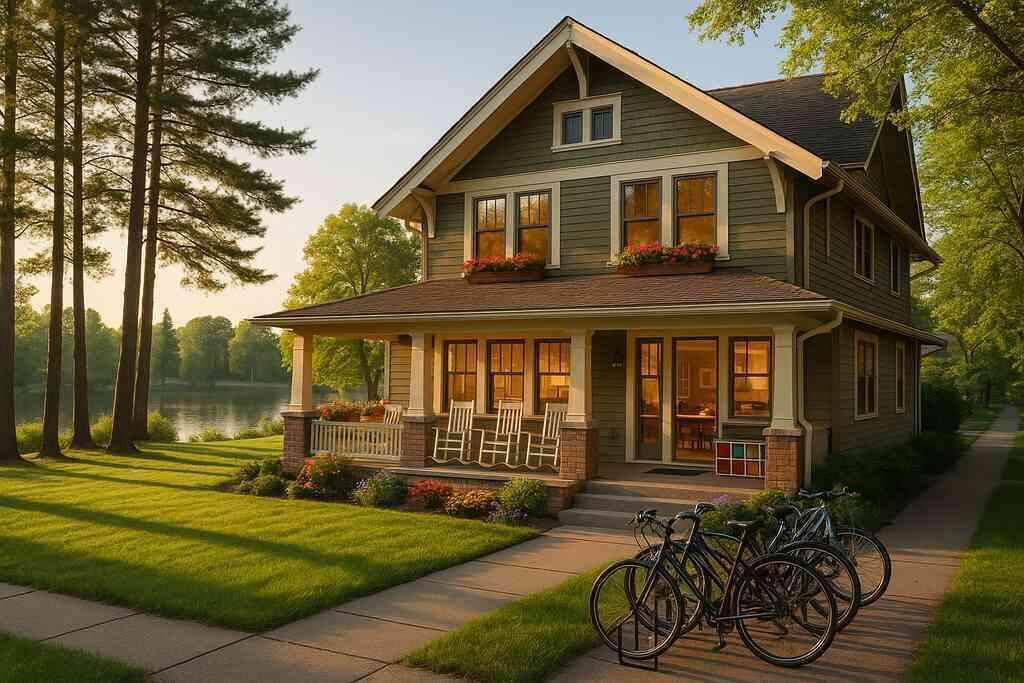
Reviewing Sober House Living Standards for 2025 Near You
October 6, 2025
The Dawn of a New Era in Sober Living
Pioneering the Path: Sober Housing in 2025
In 2025, sober housing is evolving into a more comprehensive and structured environment. The commitment to ensuring a safe place for individuals in recovery is more prominent than ever. Sober housing communities are becoming pivotal in shaping recovery journeys, anchored in new, advanced methodologies that prioritize long-term sobriety. By sculpting environments designed to foster personal growth and resilience, facilities are setting a high standard for what it means to live soberly. This year marks a transformation in how sober living homes operate, as they become robust pillars in the fight against addiction.
Bridging Tradition and Innovation in Sober Environments
Sober living homes today are not just about tradition; they represent a blend of time-honored practices and cutting-edge strategies. This synthesis is crucial for creating sober environments that resonate with residents. Enhanced compliance measures, like those seen in compliant sober living homes, are strengthening the framework within these communities, ensuring both safety and efficiency. Residents benefit from environments that acknowledge past successes while integrating futuristic models designed to meet varied recovery needs. Thus, these sober houses are not just places for recovery; they are dynamic spaces for innovation and growth.
Redefining Standards: Modern Sober Living Expectations
The standards for sober living in 2025 emphasize a balanced approach, combining stringent policies with compassionate care. The expectations have transcended beyond mere accommodation; now, the focus is on developing a holistic recovery experience. Modern sober environments are engineered to provide structure without stifling personal development. This evolution signals a shift toward more supportive and nurturing settings, where the focus is on empowering residents to thrive. By adopting best practices and adapting to the needs of the community, sober living homes are setting new benchmarks for excellence in the field.
Comprehending the Core of Sober Living Standards
Inspecting the Foundation: Quality Sober Housing Protocols
Quality sober housing protocols form the bedrock of a successful recovery journey. They ensure that sober house residents receive the necessary support and guidance throughout their stay. These protocols highlight the importance of a structured environment, offering routines that foster discipline and accountability. By implementing these stringent guidelines, sober living facilities create spaces that not only prevent relapse but also promote personal growth and self-sufficiency. Furthermore, by leveraging real-world feedback from participants in sober living communities in New York, these homes continuously refine their approaches, tailoring experiences to enhance recovery outcomes.
Accrediting Trust: Certified Sober Houses and Compliance
Certification and compliance are paramount in establishing trust with residents and their families. Certified sober houses adhere to established industry standards, ensuring safe and effective environments for recovery. This trust is crucial, as it reassures residents that they are in a legitimate and supportive setting. Compliance mechanisms, such as regular audits and inspections, reinforce this trust, highlighting the commitment to maintaining excellence within sober living homes. The luminescence of these practices can be seen in diverse places, from sober homes in Illinois to other parts of the country, where accreditation elevates the entire recovery landscape.
Evaluating Effectiveness: Structured Environments and Their Impact
The efficacy of structured environments in sober houses cannot be overstated. These environments are meticulously designed to offer a balanced mix of freedom and supervision. This balance is crucial, allowing individuals the opportunity to relearn personal responsibility while still under a protective umbrella of guidance. The impact of such arrangements is profound, significantly enhancing the chances of successful long-term sobriety. Moreover, structured environments, like those seen in structured sober environments in Minnesota, contribute to tackling issues like alcohol abuse head-on, offering a systematic approach to overcoming addiction. This focus on structure and its benefits underscores the core ethos that drives sober house standard practices across the nation, redefining what effective recovery should look like.

The Evolution of Sober Housing Policies
From Concept to Creation: Updated Sober Living Guidelines
In the ever-changing landscape of sober living, updating guidelines to reflect current needs is paramount. The evolving sober living policies for 2025 hinge on an integrative approach, combining contemporary therapeutic methodologies with tried-and-true recovery principles. A focus on individualized recovery pathways to addiction recovery ensures that each resident receives personalized plans that cater to their specific journey. This tailored approach enhances the efficacy of supportive environments, providing each individual with a framework for sobriety that is both adaptable and robust. Furthermore, the inclusion of digital tools and resources allows residents to access a wealth of information, ensuring they remain informed and empowered throughout their stay.
The Next Frontier: Innovations in Sober Living Programs
Sober living is on the brink of a revolutionary shift as new innovations shape recovery programs. Facilities are emphasizing the importance of combining traditional therapy sessions with modern technological solutions. This synthesis allows for a sober environment that is both nurturing and cutting-edge. Innovations such as virtual reality therapy and AI-driven personalized recovery plans are being introduced to elevate the recovery journey 2025 experience. These groundbreaking strategies enable residents to engage in their recovery in novel and meaningful ways, fostering resilience and adaptability. As part of this forward-thinking approach, sober homes are now focusing on mental health treatment options to address underlying psychological issues, ensuring comprehensive care.
Future-Ready: Evolved Rules for Dynamic Sober Communities
To prepare for the future, sober living homes are implementing rules that reflect the dynamic nature of recovery. These evolved sober living rules highlight the importance of continual adaptation and learning within the community. Sober houses are adopting flexible guidelines that empower residents to take ownership of their recovery while still under the watchful guidance of trained professionals. This empowerment is crucial for cultivating independence and long-term sobriety. Additionally, community-oriented initiatives are being introduced to foster understanding of support group roles, emphasizing peer support and collaborative growth. By aligning these elements, sober houses craft a resilient community that thrives on mutual support and unwavering commitment to sobriety.
These updates to policies and programs are not just about change; they’re about pioneering a new era of recovery that aligns with modern needs and technologies, ensuring that every resident has the tools they need to navigate their journey effectively. The sober living environments in California exemplify these advancements, showcasing how regional adaptations can lead to groundbreaking recovery outcomes.
Empowering a Path to Long-Term Sobriety
Unwavering Support: Cultivating Community and Peer Relationships
In the landscape of sober living, the cultivation of community and peer relationships is paramount. A supportive network serves as an anchor for individuals navigating their journey towards sobriety. Notably, communal relationships create an environment of trust and shared experiences, which are crucial for long-term recovery. The power of understanding and empathy within these communities cannot be overstated, as they provide the emotional backing that residents need. This communal approach is evident in initiatives focusing on understanding support group roles, which play a pivotal role in the recovery process. By fostering these connections, sober houses offer invaluable support that significantly enhances recovery outcomes and sustains sobriety.
Embracing Change: Forward-Thinking Recovery Residences
As sober living homes step into the future, embracing change becomes a key driver for progress. Forward-thinking recovery residences integrate both innovative and traditional recovery strategies to create dynamic sober environments. The integration of modern recovery residences signifies a shift towards versatile living spaces that adapt to the evolving needs of residents. These advanced homes prioritize mental health treatment options, addressing the psychological aspects of addiction recovery. By fusing groundbreaking therapies with a compassionate environment, the path to rehabilitation is significantly enhanced. This holistic approach prepares residents for a successful transition into a life of sobriety, fostering resilience and adaptability in every step of their journey.
From Recovery to Prosperity: Sustaining Long-term Success
Sustaining long-term success in sobriety extends beyond the walls of sober living homes. It’s about building a foundation that supports residents’ continuous growth and independence. Educational programs, life skills workshops, and mentorship opportunities are integral in this transformative process. These elements equip residents with the tools necessary to thrive beyond recovery centers. The tailored approach, evident in diverse techniques from sober living compliance in Georgia to recovery house options in New Jersey, underscores the importance of personalized support plans. Importantly, pathways to addiction recovery are designed to empower individuals to maintain sobriety while achieving personal prosperity. This focus on growth and self-sufficiency ensures that sobriety is not just a phase but a lifelong commitment.

Charting the Course for Future Sober Living
Envisioning Tomorrow: The Future of Sober Living Homes
The future of sober living homes is marked by an unprecedented integration of technology, personalized care, and community-focused models. As we look ahead, sober housing is expected to leverage artificial intelligence to offer highly personalized recovery plans, ensuring that each resident’s unique needs are addressed meticulously. Moreover, these homes will likely see the increased utilization of telehealth services, enabling access to crucial mental health resources remotely. By harnessing such advancements, sober living facilities can provide a more seamless transition for residents as they move from rehabilitation to independent living. This forward-looking approach promises to revolutionize pathways to addiction recovery, offering a framework where technology and human connection work hand in hand to foster lasting sobriety.
Continuous Improvement: Staying Ahead with Innovative Techniques
In the realm of sober living, continuous improvement through innovation is imperative. Facilities are increasingly adopting next-gen technologies aimed at enhancing recovery processes and experiences. Immersive techniques like virtual reality-dependent therapy are being piloted, allowing residents to safely confront and navigate triggers within controlled environments. These innovations not only deliver safe places for residents to hone their coping strategies but also maintain a supportive environment that encourages progress. Such advancements are particularly relevant in sober housing in Florida, where facilities are continually adapting to meet the diverse needs of their communities. By keeping pace with technological and therapeutic trends, sober living homes can remain at the forefront of providing top-tier recovery support.
Commitment to Excellence: Ensuring High-Quality Sober Environments
Commitment to excellence in sober living environments is more than just a goal-it is an ongoing pursuit. Establishing high-quality sober environments involves regular audits and compliance checks to ensure both safety and efficacy in recovery practices. Trusted sober housing accreditation, informed by industry standards and participant feedback, plays a crucial role in maintaining these quality benchmarks. This meticulous approach is evident in facilities focusing on recovery houses in Ohio, where a commitment to quality is reflected in every aspect of the resident experience. By prioritizing excellence, sober living homes not only enhance their reputation for quality care but also ensure that their residents are given the best possible foundation for long-term sobriety.
Frequently Asked Questions
Question: What makes the sober house standards in 2025 different from previous years?
Answer: The sober house standards in 2025 are a blend of proven traditional practices with innovative new methodologies. This year marks significant advancements like the integration of technology, such as virtual reality therapy and AI-driven recovery plans, which are revolutionizing recovery programs. These modern sober environments prioritize personalized and adaptive frameworks for sobriety, ensuring that each resident’s unique recovery journey is supported with customized plans. At Top Sober House, we ensure that our comprehensive directory connects you with the best, compliant sober homes that are certified and adhere to these high standards set for 2025.
Question: How does Top Sober House ensure the quality of sober living homes listed in their directory?
Answer: Top Sober House is committed to maintaining excellence in the quality of sober living homes featured in our directory. We focus on accreditation and compliance as paramount criteria, ensuring that all listed sober houses meet stringent quality standards and undergo regular audits and inspections. Our trusted sober housing options reflect industry benchmarks, providing safe and effective environments for recovery. By leveraging participant feedback and incorporating emerging trends, we continuously refine our listings to guarantee residents access to the most reliable sober environments nationwide.
Question: What innovations are influencing the future of sober living homes, especially in 2025?
Answer: The future of sober living homes is profoundly influenced by technological innovations and a forward-thinking approach. In 2025, facilities are adopting next-gen recovery programs featuring virtual reality-dependent therapy and AI-based personalized recovery strategies. Additionally, the increased utilization of telehealth services is enabling access to essential mental health resources remotely. These innovations foster a balanced, structured sober environment that maintains a high level of support while embracing modern therapies. Top Sober House ensures you’re connected with pioneering facilities at the forefront of these advancements, setting new standards in addiction recovery and long-term sobriety.
Question: Can you explain how Top Sober House supports individuals seeking sober living near them?
Answer: Top Sober House provides a user-friendly platform that helps individuals easily locate their ideal sober living environment. Our directory is enriched with knowledgeable resources and tools designed to streamline the search process. Whether you are looking for compliant sober homes, halfway houses, or recovery communities, our service provides comprehensive options aligned with modern sober house standards for 2025. We prioritize safe, structured environments that foster personal growth, ensuring individuals receive the supportive framework necessary for their recovery journey.
Question: How do sober living guidelines for 2025 foster community and peer support?
Answer: The updated sober living guidelines for 2025 emphasize the critical role of community and peer support in recovery. Sober houses are designed to foster communal relationships, creating an environment where trust and shared experiences bolster long-term recovery. Initiatives highlighting peer support are pivotal, as they empower residents to thrive through mutual understanding and cooperation. Top Sober House connects individuals to facilities that prioritize these evolved sober living rules, cultivating resilient communities that pave the way for successful recovery and sustained sobriety.


